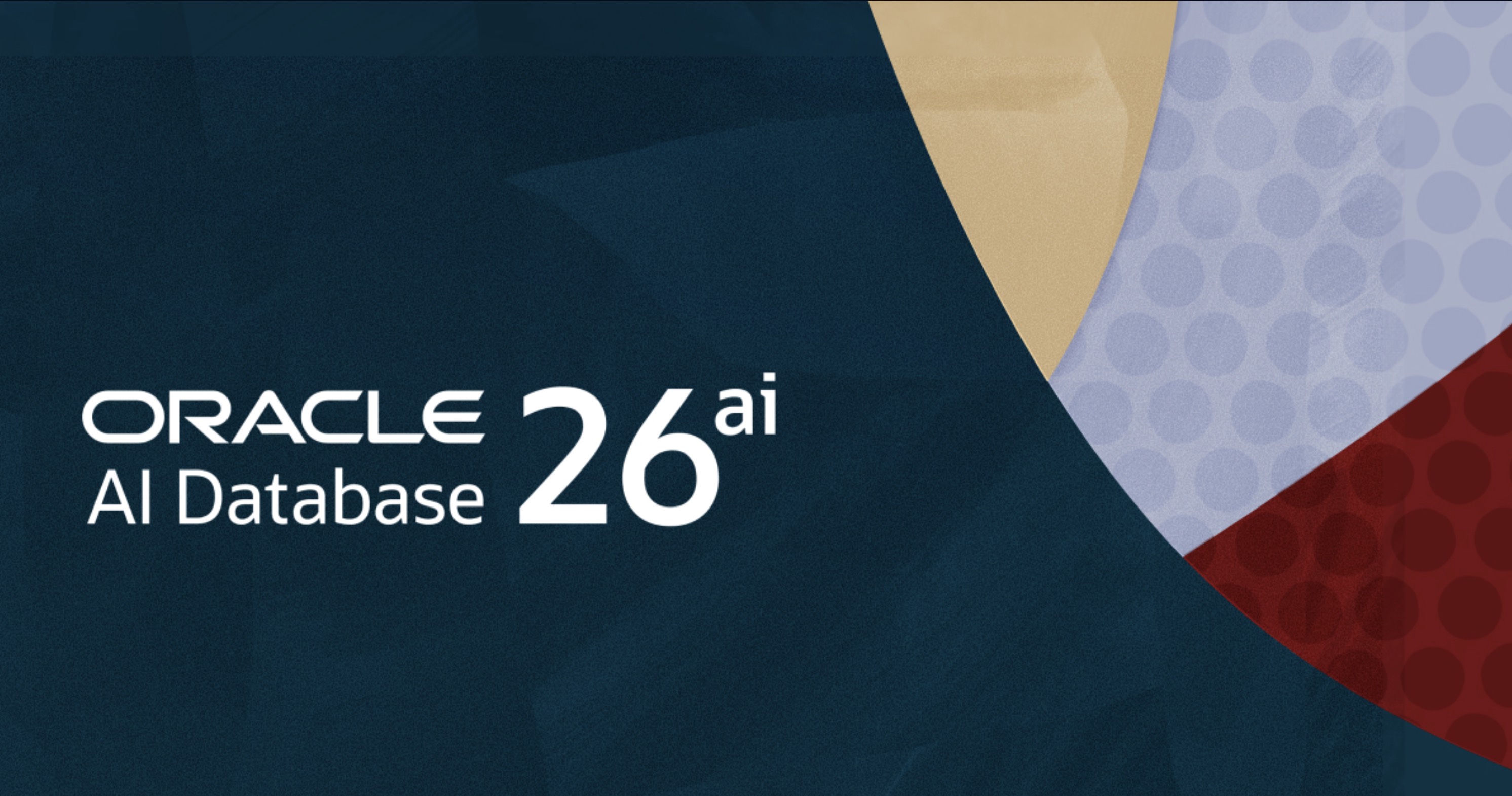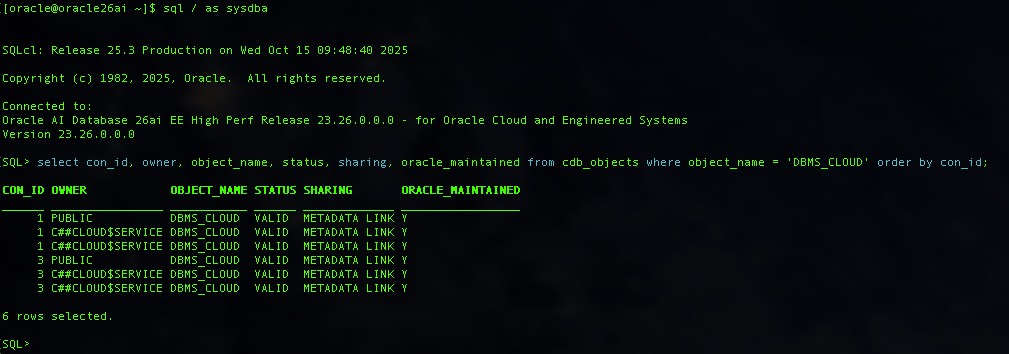Oracle AI Database 26ai
About Oracle AI Database 26ai

Oracle AI Database 26ai replaces Oracle Database 23ai
Release example…
April 2025: Oracle Database 23ai – 23.8.0.25.04
July 2025: Oracle Database 23ai – 23.9.0.25.07
October 2025: Oracle AI Database 26ai – 23.26.0.0.0 -----------> Now
January 2026: Oracle AI Database 26ai – 23.26.1.0.0
April 2026: Oracle AI Database 26ai – 23.26.2.0.0
Oracle AI Database 26ai is the next long-term support release of Oracle AI Database. It includes over 300 new features with a focus on artificial intelligence (AI) and developer productivity. Features such as AI Vector Search enable you to leverage a new generation of AI models to generate and store vectors of documents, images, sound, and so on; index them and quickly look for similarity while leveraging the existing analytical capabilities of Oracle AI Database. This combined with the already extensive set of Machine Learning algorithms enables you to quickly create sophisticated AI-enabled applications. Oracle AI Database 26ai also uses AI to optimize many of the key database functions to make more accurate estimates on timings and resource costings.
New developer-focused features now make it simpler to build next-generation applications that use JSON or relational development approaches or both interchangeably. New microservice and messaging functionality improves upon Oracle AI Database's extensive support for this key design methodology. If you need to distribute or shard your database because of regulatory or performance requirements, Oracle AI Database 26ai adds new RAFT protocol support to make it easier than ever before.
Oracle AI Database 26ai also includes significant improvements to SQL and PL/SQL, introducing new data types and language enhancements to create new or improve existing OLTP or analytical applications. While Oracle AI Database is widely regarded as the most secure database in the industry, many new capabilities, such as SQL Firewall, enable you to control exactly what SQL is executed against your database.
To help DBAs, Oracle AI Database 26ai further refines many of the key management tasks, reducing their complexity and improving their performance as well as introducing new functionality to simplify tasks, such as reclaiming free space in tablespaces. Oracle AI Database also adds new performance improvements both at an infrastructural level (with technologies like True Cache) and at the SQL level, ensuring some statements will execute many times faster.
Oracle AI Database - Basedb 26ai
DBMS_CLOUD
Create schema:
$ORACLE_HOME/perl/bin/perl $ORACLE_HOME/rdbms/admin/catcon.pl -u sys/"WElcome12345#-" -force_pdb_mode 'READ WRITE' -b dbms_cloud_install -d $ORACLE_HOME/rdbms/admin/ -l /tmp catclouduser.sql
Install packages.
$ORACLE_HOME/perl/bin/perl $ORACLE_HOME/rdbms/admin/catcon.pl -u sys/"WElcome12345#-" -force_pdb_mode 'READ WRITE' -b dbms_cloud_install -d $ORACLE_HOME/rdbms/admin/ -l /tmp dbms_cloud_install.sql
Logs:
[oracle@oracle26ai tmp]$ $ORACLE_HOME/perl/bin/perl $ORACLE_HOME/rdbms/admin/catcon.pl -u sys/"WElcome12345#-" -force_pdb_mode 'READ WRITE' -b dbms_cloud_install -d $ORACLE_HOME/rdbms/admin/ -l /tmp catclouduser.sql
catcon::set_log_file_base_path: ALL catcon-related output will be written to [/tmp/dbms_cloud_install_catcon_7261.lst]
catcon::set_log_file_base_path: catcon: See [/tmp/dbms_cloud_install*.log] files for output generated by scripts
catcon::set_log_file_base_path: catcon: See [/tmp/dbms_cloud_install_*.lst] files for spool files, if any
catcon.pl: completed successfully
[oracle@oracle26ai tmp]$ $ORACLE_HOME/perl/bin/perl $ORACLE_HOME/rdbms/admin/catcon.pl -u sys/"WElcome12345#-" -force_pdb_mode 'READ WRITE' -b dbms_cloud_install -d $ORACLE_HOME/rdbms/admin/ -l /tmp dbms_cloud_install.sql
catcon::set_log_file_base_path: ALL catcon-related output will be written to [/tmp/dbms_cloud_install_catcon_7587.lst]
catcon::set_log_file_base_path: catcon: See [/tmp/dbms_cloud_install*.log] files for output generated by scripts
catcon::set_log_file_base_path: catcon: See [/tmp/dbms_cloud_install_*.lst] files for spool files, if any
catcon.pl: completed successfully
[oracle@oracle26ai tmp]$
Check and Confirm
select con_id, owner, object_name, status, sharing, oracle_maintained from cdb_objects where object_name = 'DBMS_CLOUD' order by con_id;
SQL> select con_id, owner, object_name, status, sharing, oracle_maintained from cdb_objects where object_name = 'DBMS_CLOUD' order by con_id;
CON_ID OWNER OBJECT_NAME STATUS SHARING ORACLE_MAINTAINED
______ ________________ ___________ ______ _____________ _________________
1 PUBLIC DBMS_CLOUD VALID METADATA LINK Y
1 C##CLOUD$SERVICE DBMS_CLOUD VALID METADATA LINK Y
1 C##CLOUD$SERVICE DBMS_CLOUD VALID METADATA LINK Y
3 PUBLIC DBMS_CLOUD VALID METADATA LINK Y
3 C##CLOUD$SERVICE DBMS_CLOUD VALID METADATA LINK Y
3 C##CLOUD$SERVICE DBMS_CLOUD VALID METADATA LINK Y
6 rows selected.
SQL>

Ref
The DBMS_CLOUD family of packages consists of the following:
DBMS_CLOUD
DBMS_CLOUD_AI
DBMS_CLOUD_NOTIFICATION
DBMS_CLOUD_PIPELINE
DBMS_CLOUD_REPO
Overview of Installation and Configuration Steps
To set up DBMS_CLOUD, the following installation and configuration steps must be completed:
Installing and configuring DBMS_CLOUD:
Create a schema owning the DBMS_CLOUD package, and install the DBMS_CLOUD code in the container database (CDB), and all pluggable databases (PDBs).
Create a wallet to contain the certificates required to access HTTP URIs and Object Stores.
Configure your database environment to use the new SSL wallet.
Configure your database with access control lists (ACLs) for DBMS_CLOUD.
Verify the configuration of DBMS_CLOUD.
Configuring users or roles to use DBMS_CLOUD:
Grant the minimal privileges to a user or role for using DBMS_CLOUD
Configure ACLs for a user or role to use DBMS_CLOUD
Verify the proper setup of your user or role for using DBMS_CLOUD
To use the DBMS_CLOUD family of packages on a customer-managed Oracle Database, you must create a new user and install DBMS_CLOUD packages as that user.
The default DBMS_CLOUD procedure installation is owned by a separate schema, the C##CLOUD$SERVICE schema. The schema is locked by default so that no connections are directly made as this user.
When you update to a release update (RU) has a new DBMS_CLOUD deployment, you must rerun the installation procedure on top of your existing procedure on the PDBs where you want to access the DBMS_CLOUD family of packages. The installation is written-idempotent, so you do not have to uninstall and reinstall the DBMS_CLOUD family of packages, but the user you create to administer this installation can connect to the schema.
To ensure correct installation of DBMS_CLOUD into any existing and future pluggable databases (PDBs), install the packages using the catcon.pl utility that is located in the directory Oracle home/rdbms/admin/. The code and installation scripts for DBMS_CLOUD are part of the Oracle distribution. The two main scripts are:
catclouduser.sql: This script creates the schema C##CLOUD$SERVICE with the necessary privileges. Do not modify this script.
dbms_cloud_install.sql: This script installs the DBMS_CLOUD packages in schema C##CLOUD$SERVICE. Do not modify this script.
###
Have a good work&life! 2025/10 via LinHong